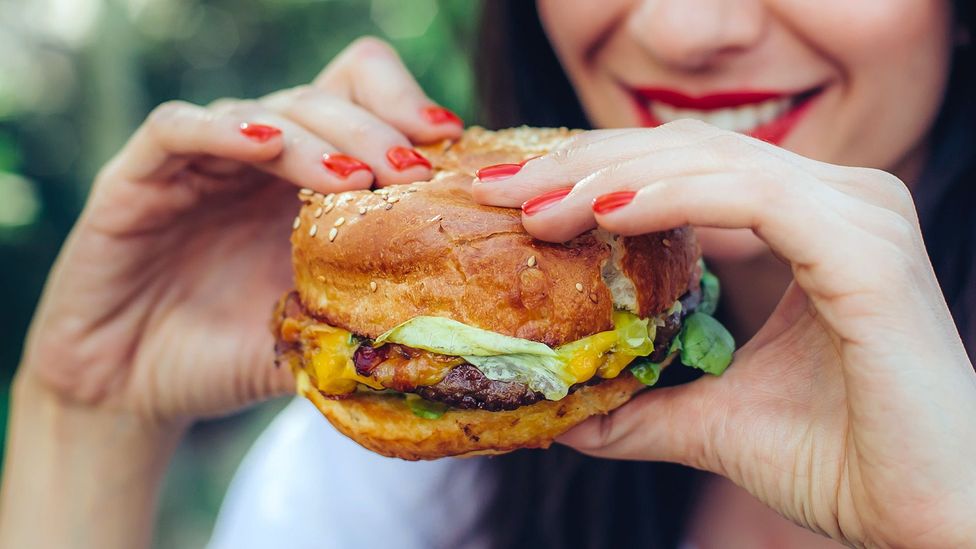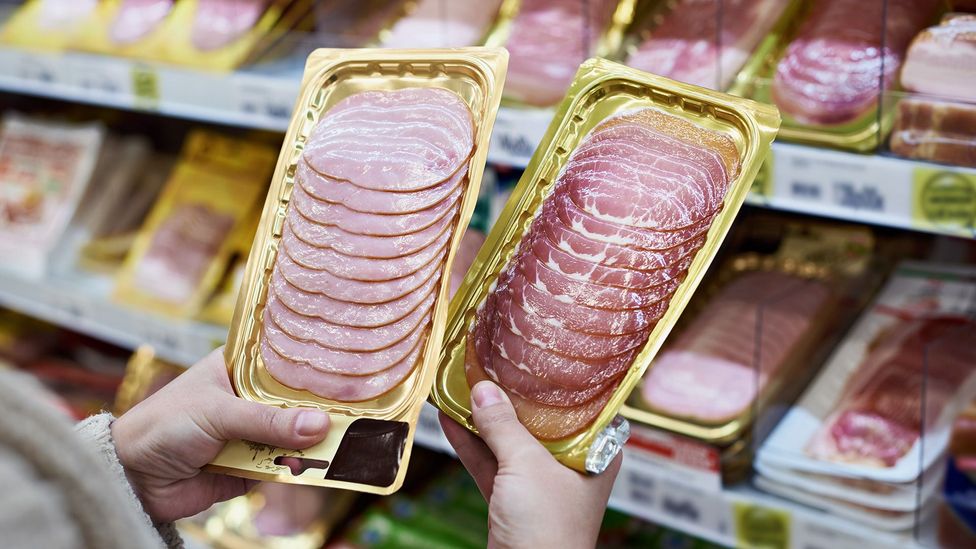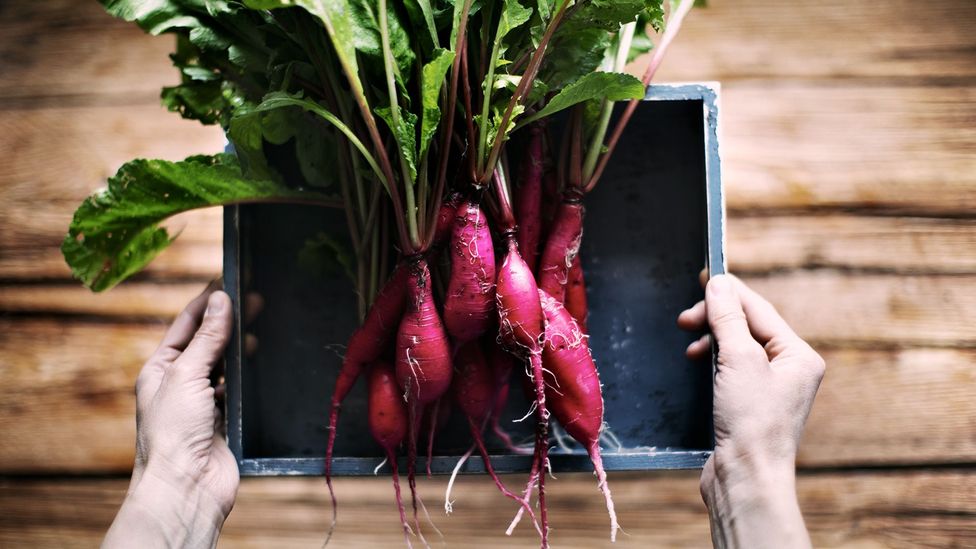Nitrates And Vitamin C
This website is produced by BBC Global News, a commercial company owned by the BBC (and just the BBC). No money from the licence fee was used to create this website. The money we make from it is re-invested to help fund the BBC's international journalism.
The truth about the nitrates in your food

Usually associated with processed meats, nitrates and nitrites are potentially cancer-causing compounds. But what are they, really – and are they always detrimental?
"Nitrates" may make you think of school chemistry lessons or fertilisers. They're probably less likely to be something you'd associate with dinner.
If you do think of nitrates in the context of food, it is probably a negative image that comes to mind – in particular, perhaps, the recent call for nitrate and nitrite preservatives to be banned from bacon and ham because of potential cancer-causing effects.
But the relationship between dietary nitrates/nitrites and health is a lot more nuanced than merely saying "they're bad for us". For example, the high natural nitrate content of beetroot juice has been credited with lowering blood pressure and enhancing exercise performance. Nitrates are also the active ingredient in some medications for angina, a condition in which reduced blood flow causes chest pain.
So are nitrates and nitrites actually bad for us?
You might also like:
• Are any foods safe to eat anymore?
• We don't need nearly as much protein as we consume
• Is a low-salt diet healthy?
Nitrates and nitrites, such as potassium nitrate and sodium nitrite, are naturally occurring chemical compounds which contain nitrogen and oxygen. In nitrates the nitrogen is bonded with three oxygen atoms, while in nitrites the nitrogen is bonded with two oxygen atoms. Both are legal preservatives which suppress harmful bacteria in bacon, ham, salami and some cheeses. (Read more about how cured meats protect us from food poisoning).
From all the furore around processed meat, you may imagine it is the major source of nitrates in our diet. But in fact only around 5% of nitrates in the average European diet come from this source, while more than 80% are from vegetables. Vegetables acquire nitrates and nitrites from the soil they grow in – nitrates are part of natural mineral deposits, while nitrites are formed by soil microorganisms that break down animal matter.

Carrots are one rich source of nitrates, which they acquire from the soil they grow in (Credit: Getty)
Leafy greens like spinach and rocket tend to be top of the crop for nitrate content, with other rich sources include celery and beetroot juices, and carrots. Organically grown vegetables may have lower levels than non-organic vegetables as synthetic nitrate fertilisers aren't used.
However, there's an important difference between the way nitrates and nitrites are packaged in meat versus from vegetables – and that affects whether they're carcinogenic, too.
Cancer connection
Nitrates are fairly inert by themselves, meaning they are unlikely to get involved in chemical reactions in the body. But nitrites, and the chemicals formed from them, are much more reactive.

Unlike in vegetables, the nitrites in processed meats are in close proximity to proteins (Credit: Getty)
Most of the nitrites we encounter aren't consumed directly, but are converted from nitrates by the action of bacteria found in our mouth. Interestingly, research shows that use of an anti-bacterial mouth wash can massively cut down this oral manufacture of nitrites.
When the nitrites manufactured in our mouth are swallowed, one of the things that can happen is that they react in the strongly acidic environment of the stomach to form nitrosamines – some of which are carcinogenic and have been linked with bowel cancer.
But for this to happen, a source of amines, chemicals related to ammonia that are found abundantly in protein foods, is required. Nitrosamines can also be created directly in foods through high-heat cooking, as with fried bacon.
"It's not so much nitrates/nitrites per se [that are carcinogenic], but the way they are cooked and their local environment that is an important factor," says Kate Allen, executive director of science and public affairs at the World Cancer Research Fund. "For example, nitrites in processed meats are in close proximity to proteins (specifically amino acids). When cooked at high temperatures this allows them to more easily form nitrosamines, the cancer-causing compound."

In processed meats, it's the nitrites' proximity to proteins, plus being cooked at high temperatures, that create cancer-causing nitrosamines (Credit: Getty)
But Allen adds that nitrites are just one reason processed meats contribute to bowel cancer, and their relative importance is uncertain. Other factors that may contribute include iron; PAHs (polycyclic aromatic hydrocarbons) which are formed in smoked meats; and HCAs (heterocyclic amines), which are created when meat is cooked over an open flame – and which also are tumour-promoting.
It's also important to keep the dangers of processed meat in context. While the International Agency for Research on Cancer categorises processed meat a carcinogen, the risk is quite small.
In the UK, for example, six out of 100 people will get bowel cancer in their lives. Of those who eat 50 grams processed meat (about three rashers of bacon) daily, the chance is seven out of 100.
Good chemicals
Nitrites aren't all bad. There's increasing evidence they may provide cardiovascular and other benefits thanks to a molecule called nitric oxide.
In 1998, three US scientists received the Nobel prize for their discoveries around the role of nitric oxide – a gas – in the cardiovascular system. We now know it dilates blood vessels, lowers blood pressure and is part of the body's armoury against infections. Limited capacity to produce nitric oxide is associated with heart disease, diabetes and erectile dysfunction.

Found in vegetables like beets, nitrites also help us form nitric oxide, which lowers blood pressure (Credit: Getty)
One way the body makes nitric oxide is from an amino acid (a building block of protein) called arginine. But it's now known that dietary nitrates can also significantly contribute to nitric oxide formation. We also know that this may be particularly important in older people, since natural nitric oxide production via arginine tends to drop with ageing.
Still, while the nitrates found in ham are chemically identical to those in the salad you might eat with it, it's the vegetable-based ones you should shoot for.
"We have observed increased risks associated with nitrate and nitrite from meats for some cancers, but we haven't observed risks associated with nitrates or nitrites from vegetables – at least in large observational studies where intake is estimated from self-reported questionnaires," says Amanda Cross, a reader in cancer epidemiology at Imperial College, London.

Nitrates in leafy greens are less likely to form cancer-causing nitrosamines and have plenty of health benefits (Credit: Getty)
Cross adds that it's "a reasonable assumption" that nitrates in leafy greens are less likely to be harmful (ie to form nitrosamines). This is because they aren't protein-rich foods and also contain protective components like vitamin C, polyphenols and fibre, which have all been shown to reduce nitrosamine formation.
So when most of the nitrates in our diets come from vegetables – and in turn encourage nitric oxide formation – they are probably good for us.
One nitric oxide expert has gone further, arguing that many of us are deficient in nitrates/nitrites and that they should be classified as essential nutrients that can help prevent conditions such as heart attacks and strokes.
Right amount
It's virtually impossible to reliably estimate dietary nitrate intake because content in food is hugely variable. "Levels can vary up to 10,000-fold for lettuce, and nitrates within drinking water can also vary considerably within the legal limit (50mg/litre)," says nutritional epidemiologist Gunter Kuhlne of the UK's Reading University.
"It means that studies investigating the effects of nitrate on health need to be interpreted very carefully, as 'nitrate' might simply be a marker of vegetable intake".
A 2017 European Food Safety Authority (EFSA) report endorsed an Acceptable Daily Intake or ADI (the amount that can be consumed over a lifetime without appreciable health risk) that equates to 235mg of nitrate for a person weighing 10 stone (63.5kg/140lb). But the report also noted that people of all age groups can exceed this ADI quite easily.

Because the nitrate content of food is hugely variable, it's difficult to be sure how much you're consuming on a daily basis (Credit: Getty)
Nitrite intakes are generally much lower (one estimate of average intake in the UK being 1.5mg per day), and EFSA says exposure to nitrite preservatives is within safe levels for all population groups in Europe, except for a slight exceedance in children with diets high in the additives.
Some experts contend that nitrate/nitrite ADIs are outdated anyway, and that higher levels are not only safe but actually beneficial – as long as they come from vegetables, not processed meats.
Having 300-400mg of nitrates in one go – potentially provided by a large rocket and spinach salad, or a beetroot juice shot – is the amount that's been linked with falls in blood pressure, for example.
As always, dose makes the poison, and levels of 2-9 grams (2000-9000mg) of nitrate can be acutely toxic, causing changes in haemoglobin that present as a blueish tinge to lips and skin. But that would be a difficult level to reach in one sitting, and very unlikely to happen from food itself – it's more of a risk from, say, exposure to fertiliser-contaminated water.
The upshot? If you want to eat the right kinds of nitrates and nitrites and avoid the potentially carcinogenic ones, then eat a widely varied diet with at least five servings a day of fruit and vegetables, and avoid nibbling on processed meats too often. That way, the benefits of nitrates and nitrates will almost certainly outweigh the downsides.
--
Correction: A previous version of this story stated that the International Agency for Research on Cancer categorises processed meat as a probable carcinogen, when it categorises it as a carcinogen. We regret the error.
Join 900,000+ Future fans by liking us on Facebook , or follow us on Twitter or Instagram .
If you liked this story, sign up for the weekly bbc.com features newsletter , called "If You Only Read 6 Things This Week". A handpicked selection of stories from BBC Future, Culture, Capital, and Travel, delivered to your inbox every Friday.
Source: https://www.bbc.com/future/article/20190311-what-are-nitrates-in-food-side-effects

0 Komentar